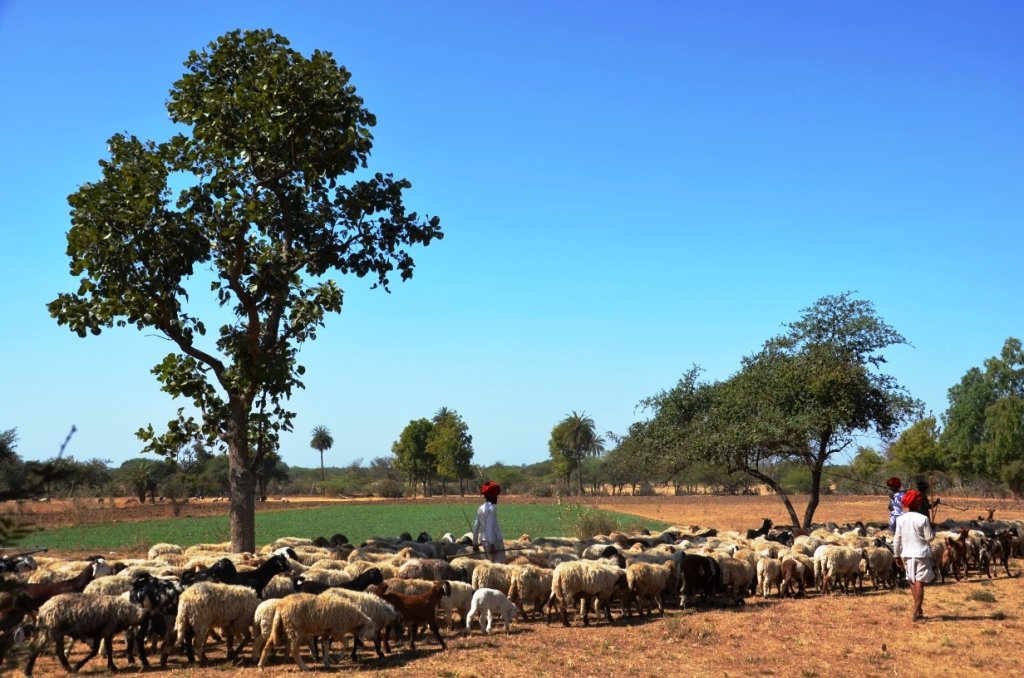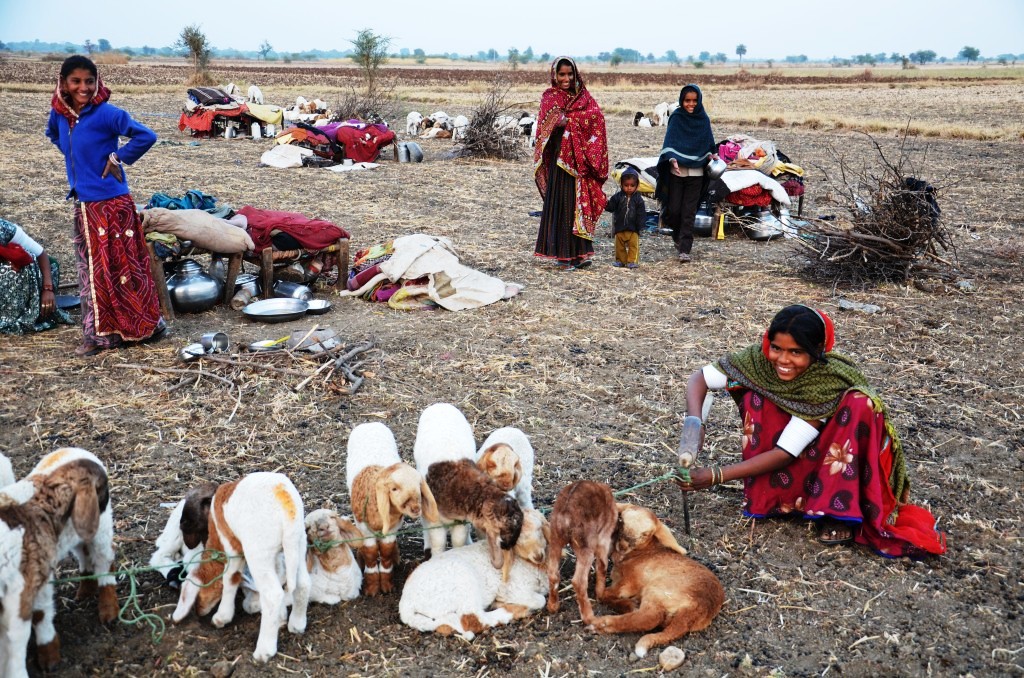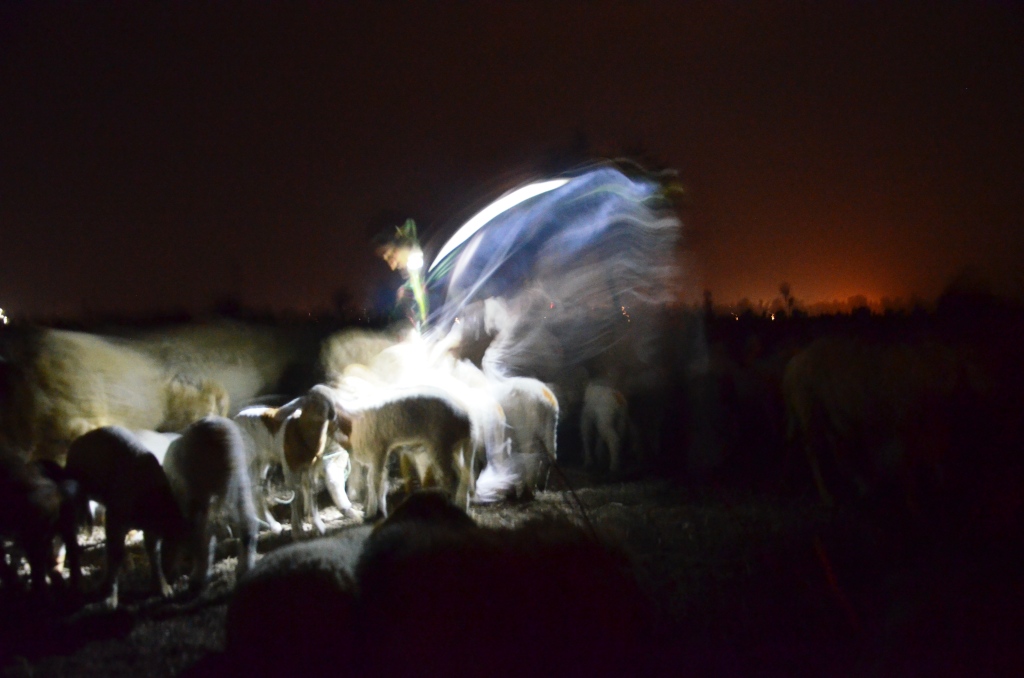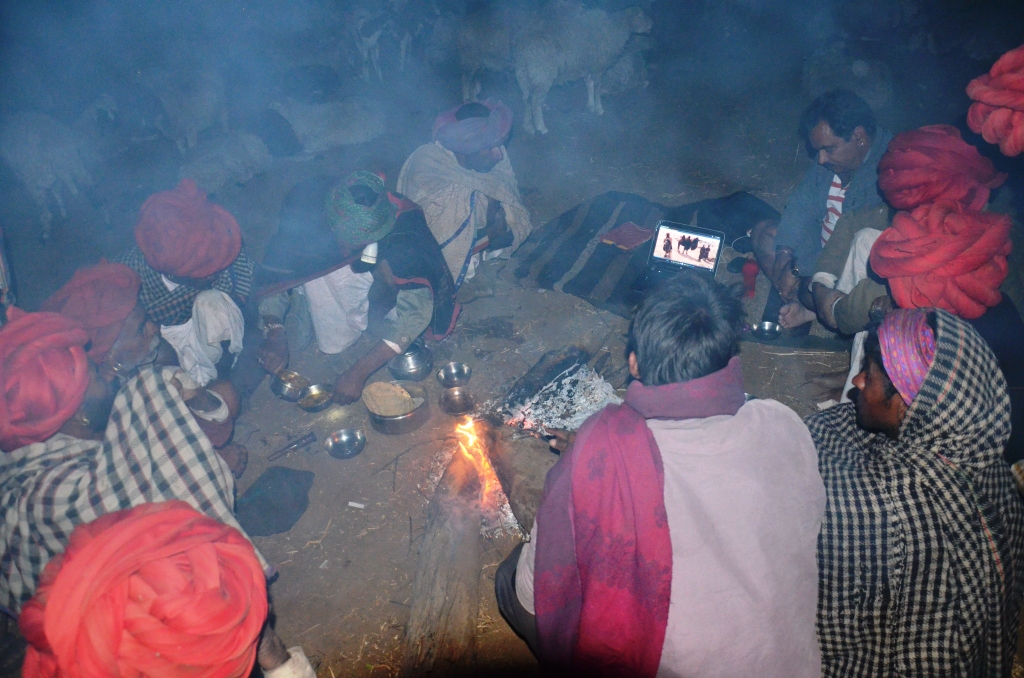
5th February, 2013, along the Udaipur-Chittorgarh highway (in Rajasthan/India), the late afternoon sun bathing everything in mellow light. Dharmabhai, the patel (leader) of his dang (herding group) is directing us to his encampment, tucked in just a few hundred meters away from the highway. There is the familiar sight of seven charpoys laid out in a square on a harvested guar (cluster bean) field. Each charpoy (string bed) signifies a nuclear family and is piled high with bedding and blankets, while cooking equipment and staple foods are stored underneath.

In the shelter of this mobile furniture, the women have set up their temporary hearths, fashioned out of broken buckets or odhis (large metal bowls, used for washing clothes, feeding animals, etc.). Freshly collected firewood is stacked neatly nearby. Rows of goat kids and sheep lambs are tied up with loops around their neck, some of them have escaped and are frolicking around. A few steps away, under the canopy of some Acacia trees, the 13 donkeys of the dang are milling around. Seven camels are hobbled on another flank of the encampment.
We drink tea, banter, exchange news with the women, children and some elder men. Everything has been well since our last visit about a month ago. No major mishaps, although everybody is nursing a cold, due to the exceptionally chilly weather this year. But the group has entered the territory of the Kanjar community that is known for thieving and other mischievous activities. In fact they were robbed by the Kanjars on this very spot a year ago. So there is a bit of nervousness, but nobody seems to be overly concerned. Around sunset, the goats belonging to the dang return and settle down. But by the time the seven main sheep flocks return, it is already dark. When they approach a choir of bleating sets off, as ewes and lambs are calling out to each other. “Here I am, here I am, where are you?” trying to locate each other. In a crowd of around 4000 sheep it is difficult to find each other, so the shepherds carry around lambs under their arms to match them with their respective mothers. In the shine of their torches, the sheep are reduced to a sea of eyes blinking at us in the dark like headlights.

After about an hour, the cacophony has ebbed out, as all lambs are united with their mothers and contentedly suckle away. Under a sea of stars, the shepherds assemble around a small fire. We are joined by the owner of the land who has brought tea leaves and sugar. He is still a young man with 100 bighas of land (“lots of land, but no water”) and highly appreciative of the shepherds, noting that the manure of their sheep would result in a bumper harvest of 14 bori (sacks) of guar. When I ask him how he would fertilize if there were no shepherds, he answers that he then would use the manure produced by his own buffaloes. But that would only result in 10-11 bori of guar, because buffalo ate grass while the sheep and goats were consuming shrubs and leaf fodder which rendered their manure much more efficient and long-lasting. And what about chemical fertilizer? He shakes his head in disagreement. “That would be much too expensive. And anyway, it turns the soil sterile and salty (”kharak”) after some time.
The conversation shifts to other issues. Hanwant shows the shepherds the film “The story of the Weeping Camel” about their pastoralist colleagues in Mongolia. They are fascinated and realize the enormous similarities with the Mongolian herders, despite the cultural and geographic distance.

And I am left to pondering. On our last visit we had been impressed how this dang – representative of many other migratory shepherds in Rajasthan and all over India – was basically producing food out of nothing, and without any carbon expenditure just by managing their sheep and goats to feed on harvested fields and surrounding trees and shrubs. This time, we have understood an additional aspect: the enormous significance of their system in reducing the need for chemical fertilizer. This is not just of benefit for the farmer who saves money, and the consumer, who obtains better tasting, “organic” food, but also to the climate. For fertilizer production is one of the most intensive greenhouse gas emitting activities that we know of.
Now, realising that these shepherds – and tens or hundreds of thousands more of them throughout India – are not only producing food without any fertilizer, but also enabling farmers to save fertilizer, shouldn’t there be a system for them to get carbon credits? And shouldn’t this function of nomadic sheep pastoralism be considered in the discussions about how to make livestock sustainable and lessen its environmental impact? Are any scientists up to calculating the green house gases saved by mobile pastoralists?

 Follow
Follow
It is wonderful.The group, the canopy of Acasia trees, the sounds of sheep and goats in evening are really calling. Thanks Dr Ilse for this lively descriptions.Look forward to more such blogs.